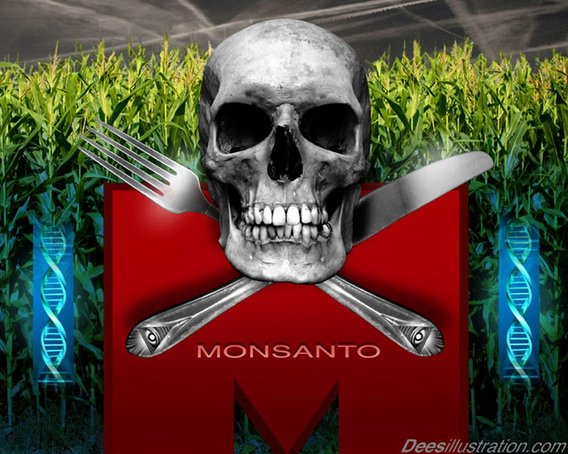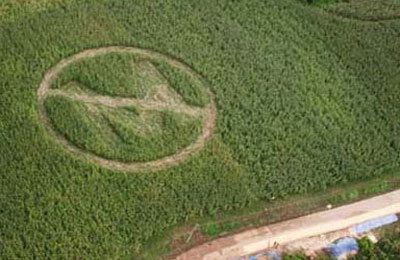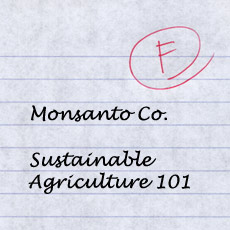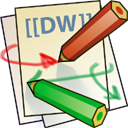Inhaltsverzeichnis
Monsanto
whois

- Monsanto Company
- DNS Administrator
- 800 N Lindbergh Blvd
- Saint Louis, MO 63167
- US
- Phone: +1.3146941000
- Email: dns.admin@monsanto.com
www

- 164.144.247.18
- open ports
- 80/tcp open http Apache httpd 2.2.21 (Unix)
- 443/tcp open ssl/http Apache httpd 2.2.21 (Unix)
- DNS Servers:
- ns4.monsanto.com
- ns3.monsanto.com
- ns1.monsanto.com
media

history
2013: Novozymes and Monsanto team up to provide sustainable bioagricultural solutions The companies establish The BioAg Alliance to discover, develop and sell microbial solutions.
2011: Monsanto Company opened a corn breeding facility today in Flora, Miss.. The Flora Corn Breeding Station utilizes the latest breeding techniques and focuses on developing higher-yielding corn hybrids. Monsanto received USDA authorization for the planting of Genuity® Roundup Ready® Alfalfa and Genuity® Roundup Ready® Sugarbeets. Monsanto acquired Divergence, Inc., a privately-held St. Louis-based biotechnology research and development company. Divergence works on controlling parasitic nematodes, including developing biotechnology traits for nematode control and nematicides with novel modes of action and superior safety profiles. Monsanto announced the launch of “Grow St. Louis,” a new community grant program designed to help grow St. Louis and improve lives locally. Through the “Grow St. Louis” program, people in the St. Louis metropolitan area can nominate eligible projects at local schools and nonprofit organizations to receive a grant of up to $15,000 from Monsanto. Monsanto acquired Beeologics, which researches and develops biological tools to provide targeted control of pests and diseases.
2010: Monsanto wins a number of workplace awards such as FORTUNE Magazine '100 Best Companies to Work For', The Scientist 2010 Best Places to Work, CR Magazine's '100 Best Corporate Citizens', and the DiversityInc Top 50 Companies for Diversity. Monsanto worked with the Haitian Ministry of Agriculture, Kuehne + Nagel, USAID and UPS to put more than 130 tons of conventional corn and vegetable seeds in the hands of Haitian farmers to increase food production and aid long-term earthquake recovery Monsanto reaffirms its strong ties to the St. Louis region with the reacquisition of the Chesterfield Village Research Center located in Chesterfield, Mo. from Pfizer Inc. Monsanto’s vegetable brands introduce Beneforte Brocolli which naturally boosts the body’s antioxidant enzyme levels at least two times more compared to other leading broccoli varieties and the EverMild onions which delivers multiple benefits, including a natural sweetness and mildness that maximizes flavor and a low “bite”. Monsanto announced the launch of a new herbicide for cotton and soybean acres called Warrant™ Herbicide. Monsanto opened its research megasite in Lubbock. The Monsanto Texas Cotton Breeding and Technology Center is a central point for the company’s breeding and testing programs in the High Plains region.
2009: Monsanto opens the Water Utilization Learning Center in Gothenburg, Nebraska. The facility is the first of its kind in agriculture and focuses on how to maintain or increase crop productivity by maximizing the crop’s water use – and what are the tools farmers need to do this. Monsanto donates approximately 4,000 cotton molecular markers and associated information to Texas AgriLife Research, a part of the Texas A&M system. The donation is offered to the public domain through the globally accessible cotton genome databases, a move that will benefit research programs and breeders interested in one of world's key crops. Monsanto announces a $10 million grant to establish Monsanto's Beachell-Borlaug International Scholars Program, which will help identify and support young scientists interested in improving research and production in rice and wheat, two of the world's most important staple crops, through plant breeding techniques. Monsanto launches Genuity™, a new family of traits designed to work together to enhance crop potential and simplify trait selection for farmers. Monsanto announces Project SHARE (Sustainable Harvest - Agriculture, Resources, Environment) – a sustainable yield initiative to improve farmer lives in India. Project SHARE, a pilot project in association with ISAP (Indian Society of Agribusiness Professionals), aims to improve the socio-economic conditions of 10,000 small-marginal cotton and corn farmers in 1,100 villages across three states within four years, by increasing their crop productivity.
2008: Monsanto acquires Aly Participacoes Ltda., which operates the sugarcane and breeding technology companies, CanaVialis S.A. and Alellyx S.A., both based in Brazil. With this acquisition, Monsanto enters the sugarcane industry. Monsanto introduces Acceleron® brand seed treatments. The Acceleron brand launched with Roundup Ready 2 Yield soybeans, is expected to be available in SmartStax corn in 2010, Deltapine cotton in 2011 and in other crops in coming seasons. Monsanto sells its POSILAC® bovine somatotropin brand and related business to Eli Lilly and Company. Monsanto acquires Semillas Cristiani Burkard (SCB), a privately-held seed company headquartered in Guatemala City, Guatemala. SCB is the leading Central American corn seed company focused on hybrid corn production. Monsanto acquires De Ruiter Seeds Group, B.V., a Dutch holding company that owns and operates De Ruiter Seeds. De Ruiter Seeds breeds, produces and sells hybrid vegetable seeds for top vegetable products such as tomato, cucumber, aubergine, pepper, melon and rootstock. De Ruiter Seeds is one of the top breeding companies in the world. Monsanto announces its three-point commitment to sustainable agriculture. This commitment includes: helping farmers double yield in corn, soybeans and cotton by 2030, compared to a base year of 2000; developing seeds that will reduce by one-third per unit produced the aggregate amount of key resources, such as land, water and energy, required to grow crops by 2030; improving the lives of farmers, including an additional five million people in resource-poor farm families, by 2020. To learn more, visit: www.improveagriculture.com Monsanto introduces Roundup Ready 2 Yield® soybean technology, the second generation of the popular Roundup Ready® technology farmers have used since 1996. This product offers the same effective weed control, simplicity and flexibility benefits of the Roundup Ready system and it increases soybean yield potential.
2007: Monsanto joins the Chicago Climate Exchange® (CCX), North America's only voluntary, legally-binding greenhouse gas emissions reduction, registry and trading program. As part of this program, Monsanto agrees to reduce its own direct carbon emissions from major U.S. operations or purchase carbon emission offsets. Additionally, the company will work with farmer groups to discuss reducing carbon dioxide in the air by practicing no-till agriculture. Monsanto sells Monsanto Choice Genetics, Inc., the company’s swine genetics business, to Newsham Genetics, LLC. Monsanto and Dow AgroSciences announce a cross-licensing agreement aimed at launching SmartStax™, the industry’s first-ever eight-gene stacked combination in corn. Monsanto and Bayer CropScience AG announce a series of long-term business and licensing agreements related to key agricultural technologies. Monsanto acquires Delta and Pine Land Company and divests the Stoneville and NexGen cotton businesses. Monsanto forms International Seed Group, Inc. (ISG), an investment holding company that provides specialized, regional vegetable and fruit seed companies with access to capital and technology. Dr. John Franz is inducted into the National Inventors Hall of Fame® for the discovery of glyphosate – the active ingredient in Roundup® brand agricultural herbicides. Monsanto and BASF announce a long-term joint research and development (R&D) and commercialization collaboration in plant biotechnology. The collaboration will focus on the development of high-yielding crops that are more tolerant to adverse environmental conditions, such as drought.
2006: Monsanto’s ASI subsidiary acquires several regional seed companies, including Diener Seeds, Sieben Hybrids, Kruger Seed Company, Trisler Seed Farms, Gold Country Seed, Inc., Heritage Seeds and the seed marketing and sales business of Campbell Seed. Roundup Ready® Corn 2 technology is planted on more than 32 million acres – or about 40 percent of U.S. corn acres – during the 2006 crop season. Monsanto and Dow AgroSciences LLC sign a global agreement cross-licensing intellectual property, product licenses in corn and soybeans, cotton technologies, and enabling technologies. This agreement will allow both companies to offer farmers new technology options and more choice in the products to meet their needs. Monsanto introduces Roundup Ready Flex cotton, providing farmers with a wider over-the-top application window throughout the growing season, as compared to its original Roundup Ready cotton technology. Monsanto becomes the first agriculture company to introduce a stacked second-generation product when it introduces Bollgard II insect-protected cotton with Roundup Ready Flex. The product provides farmers with the same benefits as its Bollgard II product as well as its Roundup Ready Flex technology.
2005: Monsanto introduces Vistive low-linolenic soybeans. VISTIVE low-linolenic soybeans, which were produced through conventional breeding, offer the ability to reduce or eliminate trans fatty acids (trans fats) in processed soybean oil. Monsanto acquires Seminis, Inc., a global leader in the vegetable and fruit seed industry. Seminis supplies more than 3,500 seed varieties to commercial fruit and vegetable growers, dealers, distributors and wholesalers in more than 150 countries around the world. The company is headquarters in Oxnard, California Monsanto introduces the first triple-trait technology offered by any company in the agriculture industry, YieldGard Plus with Roundup Ready Corn 2. The product offers three traits in one seed - including Monsanto's two YieldGard insect-protection products and its Roundup Ready technology. Monsanto acquires the Stoneville cotton business, including its NexGen brand. Monsanto's ASI subsidiary acquires NC+ Hybrids, Inc., headquartered in Lincoln, Neb. Monsanto completes its sale of Monsanto Enviro-Chem Systems Inc. to a new company formed by the Enviro-Chem management team and an outside investor. The new company is MECS, Inc. Monsanto's ASI subsidiary acquires four companies that are the shareowners of the CORE Group - including Fontanelle Hybrids, based in Fontanelle, Neb.; Stewart Seeds, based in Greensburg, Ind.; Trelay Seeds, based in Livingston, Wis.; and, Stone Seeds, based in Pleasant Plains, Ill. In a separate transaction, ASI also acquires Specialty Hybrids, a leader serving the Eastern Corn Belt. The 2005 crop season marked the tenth season that biotech crops were planted throughout the world. The 2005 season also marked the year in which the billionth acre was planted with biotech crops and the year in which the billionth acre harvested.
2004: Monsanto introduces YieldGard Plus corn. This product is a stacked version of Monsanto's two YieldGard products in one seed product. Monsanto forms American Seeds Inc. (ASI), a holding company for mostly corn and soybeans. ASI supports regional seed businesses with capital, genetics and technology investments. Monsanto's ASI subsidiary acquires Channel Bio Corp. and its three seed brands: Crows Hybrid Corn, Midwest Seed Genetics and Wilson Seeds.
2003: YieldGard Rootworm insect-protected corn is introduced, providing farmers with in-seed insect-protection against the corn rootworm. Monsanto introduces YieldGard Rootworm insect-protected corn stacked with Roundup Ready Corn 2. The product offers two traits in one seed - including Monsanto's YieldGard Rootworm insect-protection and its Roundup Ready technology. Monsanto becomes the first agriculture company to introduce a second-generation trait product in cotton when it introduces Bollgard II insect-protected cotton. The product provides farmers with the same benefits as its original Bollgard product as well as expanded protection against other cotton pests.
2002: The new Monsanto Company is spun off from Pharmacia and is now a separate company. Monsanto becomes the first company to identify and market specific corn hybrids that can yield more ethanol per bushel. The hybrids, sold as Processor Preferred Corn hybrids, help farmers get more ethanol out of their harvest. Monsanto introduces Processor Preferred Soybean varieties. These varieties help farmers get more oil and protein out of their harvest.
2001: Monsanto becomes the first agriculture company to introduce a second-generation trait product when it introduces Roundup Ready Corn 2. The product provides farmers with a wider application window than the first generation Roundup Ready Corn technology. Monsanto places the first U.S. corporate order for the first full-size pickup trucks that run on E85, a blend of 85 percent ethanol and 15 percent gasoline.
2000: A new Monsanto Company, based on the previous agricultural division of Pharmacia, is incorporated as a stand-alone subsidiary of the pharmaceutical company. (Pharmacia itself eventually becomes a subsidiary of Pfizer, in 2003). Original Monsanto Company
2000: The original Monsanto enters into a merger and changes its name to Pharmacia Corporation. (For a detailed history about the relationships among Monsanto Company, Pharmacia Corporation, Pfizer Inc., and Solutia Inc., please click here.) 1998: The original Monsanto completes its purchase of DeKalb Genetics Corp. Roundup Ready Corn is introduced, providing farmers with in-seed herbicide tolerance to Roundup and other glyphosate-based herbicides. The original Monsanto becomes the first company to introduce a stacked trait combination in corn when it introduces YieldGard Corn Borer insect-protected corn stacked with Roundup Ready Corn. The product offers two traits in one seed - including Monsanto's YieldGard Corn Borer insect-protection and its Roundup Ready technology.
1997: YieldGard Corn Borer insect-protected corn is introduced, providing farmers with in-seed insect-protection against the European corn borer. Asgrow agronomics seed business is purchased by the original Monsanto. The original Monsanto purchases Holden's Foundation Seeds L.L.C. and Corn States Hybrid Service L.L.C., a supplier of high quality foundation seed for the corn seed industry. The original Monsanto maintains Holden's/Corn States policy of broadly licensing seed companies elite corn germplasm and trait technologies. The original Monsanto spins off its industrial chemical and fibers business as Solutia Inc. Roundup Ready Canola is introduced, providing farmers with in-seed herbicide tolerance to Roundup and other glyphosate-based herbicides. Roundup Ready Cotton is introduced, providing farmers with in-seed herbicide tolerance to Roundup and other glyphosate-based herbicides. The original Monsanto becomes the first company to introduce a stacked trait combination when it introduces Bollgard insect-protected cotton stacked with Roundup Ready Cotton. The product offers two traits in one seed - including Monsanto's Bollgard insect-protection and its Roundup Ready technology.
1996: The original Monsanto acquires the plant biotechnology assets of Agracetus and purchases an interest in Calgene, another biotech research company. (The Calgene acquisition was completed the following year.) Roundup Ready Soybeans are introduced, providing farmers with in-seed herbicide tolerance to Roundup and other glyphosate-based herbicides. Bollgard insect-protected cotton is introduced, providing farmers with in-seed insect-protection against the cotton bollworm, tobacco budworm and pink bollworm.
1994: The original Monsanto's first biotechnology product to win regulatory approval, Posilac, bovine somatotropin (Bst) for dairy cows, goes on sale in the U.S.
1987: The original Monsanto conducts the first U.S. field trials of plants with biotechnology traits.
1984: The Life Sciences Research Center opens in Chesterfield, MO., United States
1982: Scientists working for the original Monsanto are the first to genetically modify a plant cell. The original Monsanto acquires the Jacob Hartz Seed Co., known for its soybean seed.
1981: A molecular biology group has been set up and biotechnology is firmly established as Monsanto's strategic research focus.
1976: Roundup herbicide is commercialized in the U.S.
1975: A cell biology research program is established in the Agricultural Division.
1968: Commercialization of Lasso herbicide in the U.S. begins the trend toward reduced-tillage farming.
1964: Ramrod herbicide is introduced, beginning the use of Western theme names for the original Monsanto's brands of herbicides.
1960: The Agricultural Division is established.
1945: The original Monsanto produces and markets agricultural chemicals, including 2,4D.
1901: John F. Queeny founds the original Monsanto. His wife was Olga Monsanto Queeny. The first product of that company was saccharine.
Locations
Germany
Borken Monsanto Agrar Deutschland GmbH Zuchtstation Borken Borkener Str. 169 46325 Borken, Germany Phone:+49-2862-9073.10 Fax:+49-2862-9073.20
Düsseldorf Monsanto Agrar Deutschland GmbH Vogelsanger Weg 91 40470 Düsseldorf, Germany Phone:+49-211-3675.0 Fax:+49-211-3675.341
Kuenzing Monsanto Agrar Deutschland GmbH Zuchtstation Kuenzing Klingerfeldstr. 2b 94550 Kuenzing, Germany Phone: +49-8547-91497.0 Fax:+49-8547-91497.20
Neustadt Monsanto Agrar Deutschland GmbH Abteilung Gemüsesaatgut Lindenallee 33 31535 Neustadt, Germany Phone: +49-(0)5032-89 40 0 Fax: +49-(0)5032-89 40 40
Monsanto Vegetable Seeds Division Lindenallee 33 31535 Neustadt Germany Tel. +49 (0)5032 894010 www.seminis.de
Netherlands
Monsanto Vegetable Seeds Division P.O. Box 1050 2660 BB Bergschenhoek The Netherlands T. +31 10 529 22 25 www.deruiterseeds.nl
more locations
Monsanto Facilities Round the World
- Canada
- Guatemala
- Mexico
- Puerto Rico
- United States
South America
- Argentina
- Brazil
- Chile
- Colombia
- Ecuador
- Paraguay
- Peru
- Uruguay
Europe
- Albania
- Belarus
- Belgium
- Bulgaria
- Croatia
- Cyprus
- Czech Republic
- Denmark
- Finland
- France
- Germany
- Greece
- Hungary
- Ireland
- Italy
- Netherlands
- Norway
- Poland
- Portugal
- Romania
- Russia
- Slovakia
- Spain
- Sweden
- Switzerland
- Turkey
- Ukraine
- United Kingdom
Middle East
- Israel
- Jordan
- Kuwait
- Oman
- United Arab Emirates
Asia / Pacific
- Australia
- Bangladesh
- China
- India
- Indonesia
- Japan
- Kazakhstan
- Malaysia
- New Zealand
- Pakistan
- Philippines
- Singapore
- South Korea
- Sri Lanka
- Taiwan
- Thailand
- Uzbekistan
- Vietnam
Africa
- Algeria
- Kenya
- Malawi
- Morocco
- Senegal
- South Africa
- Zimbabwe

